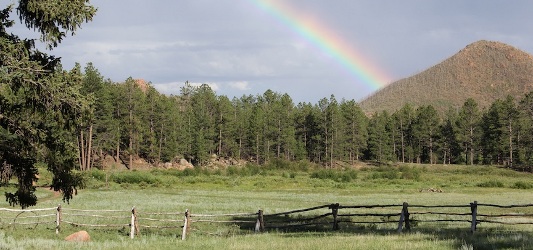
I am sitting just inside a large pane glass window which overlooks the meadow and first pasture of Buffalo Peak Ranch. The storm had been brewing all day. Finally it let go, the first, full precipitation to hit the dry soil at eight thousand feet elevation in more than two weeks.
There is something inherent in a thunderstorm and the subsequent rain that causes me to catch my breath. For me, it is completely involuntary, a joy that rises inside. Nothing feels as real, as satisfying as when the air carries the presence of ozone and the bones in my chest reverberate with successive shock waves, the earth shaking beneath my feet.
In my travels, I am often reminded of the differences in both personal and cultural reactions to temperature and weather.
Cold for a Kenyan is weather conducive to a T-shirt and shorts for someone from Colorado. Too hot for a Minnesotan is winter for someone from Dubai. The human species has found comfort in an incredibly diverse range of climates, more than any other single species on Earth. We have claimed home at more than 16,000 feet elevation and also a few hundred meters below sea level, even temporary living beneath the ocean’s surface in submersibles and research stations. We have lived for countless generations in the tropics, deserts, alpine meadows, and coastal plains. Soon, we will live on the surface of Mars, not likely to breathe outside of a dome or pressurized suit for countless generations.
In Arizona people play golf in temperatures over 43C (110F) while in Seattle, it is completely normal to run soaked to the bone, in near freezing temperatures.
In Cape Town, South Africa I was enjoying the beginning of their winter with the close of May. I opened the windows to the guest house room where I stayed each night, the cool, moist air entering with the sound of water spilling from overflowing gutters above me.
I was repeatedly asked by the locals how I managed against the weather. My response was an elated, “I love it! It’s amazing!” the next storm building outside. In response, I received looks of horror, a sense of dread as they wrapped their winter jackets around their torsos even tighter. When the temperature drops to 15C (60F), South Africans go on vacation to warmer climates.
This is not a judgment nor a criticism, but an example of how individuals, how entire societies respond to the weather. I spoke at length about this with my host at SAAO. She suggested that to cheer at a thunder clap or to remain inside behind closed doors is based on how we were raised, if we were brought up to embrace the out-of-doors or literally if we were “sheltered” in that we found comfort in buildings and cars.
For me, modern houses are too tightly wrapped, the lack of air flow stagnating when I want so much to experience what is happening outside. I have friends who cannot sleep without the constant buzz of an electric fan or television in the background. Full silence is as alien to them as is living in a city for me, traffic, gun shots, and sirens challenging my dreams.
Give me a cabin, a tent, or nothing at all as I prefer to be physically and emotionally saturated than remain inside where I am safe and dry.